Light Scattering in a Turbulent Cloud: Simulations to Explore Cloud-Chamber Experiments
Abstract
1. Introduction
2. Simulated Experiments
2.1. Summary of the Monte Carlo Ray Tracing (MCRT) Methodology
2.1.1. Overview of the MCRT Code (‘mcScatter’)
2.1.2. Use of the ‘mcScatter’ MCRT Software with Chamber-Realistic Particle Distributions
2.2. Large Eddy Simulation
2.2.1. Large Eddy Simulation Methodology
2.2.2. Cloud Microphysical and Optical Properties from the LES
3. Results
3.1. Scattering MCRT Results for LES Particle Clouds Conditioned on Estimated Optical Thickness
3.2. Statistical Properties of Fluxes with and without Spatial Correlations from Turbulent Mixing
3.3. Variation of Fluxes along the Profiles
4. Implications for Measurement of Light Propagation in a Convection Cloud Chamber
5. Discussion and Conciusions
Author Contributions
Funding
Acknowledgments
Conflicts of Interest
References
- Borovoi, A.G. Radiative transfer in inhomogeneous media. Dokl. Akad. Nauk SSSR 1984, 276, 1374–1378. [Google Scholar]
- Kostinski, A.B.; Jameson, A.R. On the Spatial Distribution of Cloud Particles. J. Atmos. Sci. 2000, 57, 901–915. [Google Scholar] [CrossRef]
- Kostinski, A.B.; Shaw, R.A. Scale-dependent droplet clustering in turbulent clouds. J. Fluid Mech. 2001, 434, 389–398. [Google Scholar] [CrossRef]
- Marshak, A.; Davis, A.B. 3D Radiative Transfer in Cloudy Atmospheres; Springer: Berlin, Germany, 2005; ISBN 978-3-540-23958-1. [Google Scholar]
- Davis, A.B.; Marshak, A. Photon propagation in heterogeneous optical media with spatial correlations: Enhanced mean-free-paths and wider-than-exponential free-path distributions. J. Quant. Spectrosc. Radiat. Transf. 2004, 84, 3–34. [Google Scholar] [CrossRef]
- Larsen, E.W.; Vasques, R. A generalized linear Boltzmann equation for non-classical particle transport. J. Quant. Spectrosc. Radiat. Transf. 2011, 112, 619–631. [Google Scholar] [CrossRef]
- Davis, A.B.; Marshak, A.; Gerber, H.; Wiscombe, W.J. Horizontal structure of marine boundary layer clouds from centimeter to kilometer scales. J. Geophys. Res. Atmos. 1999, 104, 6123–6144. [Google Scholar] [CrossRef]
- Shaw, R.A. Particle-turbulence interactions in atmospheric clouds. Annu. Rev. Fluid Mech. 2003, 35, 183–227. [Google Scholar] [CrossRef]
- Kostinski, A.B. On the extinction of radiation by a homogeneous but spatially correlated random medium. J. Opt. Soc. Am. A JOSAA 2001, 18, 1929–1933. [Google Scholar] [CrossRef]
- Larsen, M.; Clark, A. On the link between particle size and deviations from the Beer–Lambert–Bouguer law for direct transmission. J. Quant. Spectrosc. Radiat. Transf. 2014, 133, 646–651. [Google Scholar] [CrossRef]
- Frankel, A.; Iaccarino, G.; Mani, A. Optical depth in particle-laden turbulent flows. J. Quant. Spectrosc. Radiat. Transf. 2017, 201, 10–16. [Google Scholar] [CrossRef]
- Packard, C.D.; Larsen, M.L.; Cantrell, W.H.; Shaw, R.A. Light scattering in a spatially-correlated particle field: Role of the radial distribution function. J. Quant. Spectrosc. Radiat. Transf. 2019, 236, 106601. [Google Scholar] [CrossRef]
- Bohren, C.F.; Clothiaux, E.E. Fundamentals of Atmospheric Radiation: An Introduction with 400 Problems; Wiley-VCH: Weinheim, Germany, 2011; ISBN 978-3-527-40503-9. [Google Scholar]
- Chang, K.; Bench, J.; Brege, M.; Cantrell, W.; Chandrakar, K.; Ciochetto, D.; Mazzoleni, C.; Mazzoleni, L.R.; Niedermeier, D.; Shaw, R.A. A laboratory facility to study gas-aerosol-cloud interactions in a turbulent environment: The Π Chamber. Bull. Am. Meteorol. Soc. 2016. [Google Scholar] [CrossRef]
- Thomas, S.; Ovchinnikov, M.; Yang, F.; van der Voort, D.; Cantrell, W.; Krueger, S.K.; Shaw, R.A. Scaling of an Atmospheric Model to Simulate Turbulence and Cloud Microphysics in the Pi Chamber. J. Adv. Model. Earth Syst. 2019, 11, 1981–1994. [Google Scholar] [CrossRef]
- Shaw, R.A.; Kostinski, A.B.; Lanterman, D.D. Super-exponential extinction of radiation in a negatively correlated random medium. J. Quant. Spectrosc. Radiat. Transf. 2002, 75, 13–20. [Google Scholar] [CrossRef]
- Packard, C.D.; Shaw, R.A.; Cantrell, W.H.; Kinney, G.M.; Roggemann, M.C.; Valenzuela, J.R. Measuring the detector-observed impact of optical blurring due to aerosols in a laboratory cloud chamber. JARS 2018, 12, 042404. [Google Scholar] [CrossRef]
- Danielson, R.E.; Moore, D.R.; van de Hulst, H.C. The Transfer of Visible Radiation through Clouds. J. Atmos. Sci. 1969, 26, 1078–1087. [Google Scholar] [CrossRef][Green Version]
- Plass, G.N.; Kattawar, G.W. Monte Carlo Calculations of Light Scattering from Clouds. Appl. Opt. 1968, 7, 415–419. [Google Scholar] [CrossRef]
- Collins, D.G.; Blättner, W.G.; Wells, M.B.; Horak, H.G. Backward Monte Carlo Calculations of the Polarization Characteristics of the Radiation Emerging from Spherical-Shell Atmospheres. Appl. Opt. 1972, 11, 2684–2696. [Google Scholar] [CrossRef]
- Sobol’, I.M. The Monte Carlo Method. Popular Lectures in Mathematics; The University of Chicago Press: Chicago, IL, USA, 1974. [Google Scholar]
- Marchuk, G.I.; Mikhailov, G.A.; Nazaraliev, M.A.; Darbinjan, R.A.; Kargin, B.A.; Elepov, B.S. The Monte Carlo Methods in Atmospheric Optics; Springer: Berlin/Heidelberg, Germany, 1980; Volume 12. [Google Scholar]
- Cole, J.N.S. Assessing the importance of unresolved cloud-radiation interactions in atmospheric global climate models using the multiscale modelling framework. Ph.D. Thesis, Department of Meteorology, The Pennsylvania State University, State College, PA, USA, 2005. [Google Scholar]
- Henyey, L.G.; Greenstein, J.L. Diffuse radiation in the galaxy. Astrophys. J. 1941, 93, 70–83. [Google Scholar] [CrossRef]
- Thomas, G.E.; Stamnes, K. Radiative Transfer in the Atmosphere and Ocean; Cambridge University Press: Cambridge, UK, 1996; ISBN 978-0-521-40124-1. [Google Scholar]
- Ishimaru, A. Wave Propagation and Scattering in Random Media; IEEE Press: New York, NY, USA, 1997; ISBN 978-0-7803-4717-5. [Google Scholar]
- Frankel, A.; Iaccarino, G.; Mani, A. Convergence of the Bouguer–Beer law for radiation extinction in particulate media. J. Quant. Spectrosc. Radiat. Transf. 2016, 182, 45–54. [Google Scholar] [CrossRef]
- Banko, A.J.; Villafañe, L.; Kim, J.H.; Esmaily, M.; Eaton, J.K. Stochastic modeling of direct radiation transmission in particle-laden turbulent flow. J. Quant. Spectrosc. Radiat. Transf. 2019, 226, 1–18. [Google Scholar] [CrossRef]
- Mishchenko, M.I. Multiple scattering, radiative transfer, and weak localization in discrete random media: Unified microphysical approach. Rev. Geophys. 2008, 46. [Google Scholar] [CrossRef]
- Mishchenko, M.I.; Dlugach, J.M.; Yurkin, M.A.; Bi, L.; Cairns, B.; Liu, L.; Panetta, R.L.; Travis, L.D.; Yang, P.; Zakharova, N.T. First-principles modeling of electromagnetic scattering by discrete and discretely heterogeneous random media. Phys. Rep. 2016, 632, 1–75. [Google Scholar] [CrossRef] [PubMed]
- Matérn, B. Poisson Processes in the Plane and Related Models for Clumping and Heterogeneity. Ph.D. Thesis, NATO Advanced Study Institute on Statistical Ecology. Pennsylvania State University, State College, PA, USA, 1972. [Google Scholar]
- Martínez, V.J.; Saar, E. Statistics of the Galaxy Distribution; CRC Press: Boca Raton, FL, USA, 2002. [Google Scholar]
- Larsen, M.L.; Briner, C.A.; Boehner, P. On the Recovery of 3D Spatial Statistics of Particles from 1D Measurements: Implications for Airborne Instruments. J. Atmos. Ocean. Technol. 2014, 31, 2078–2087. [Google Scholar] [CrossRef]
- Khairoutdinov, M.F.; Randall, D.A. Cloud Resolving Modeling of the ARM Summer 1997 IOP: Model Formulation, Results, Uncertainties, and Sensitivities. J. Atmos. Sci. 2003, 60, 607–625. [Google Scholar] [CrossRef]
- Khain, A.; Pokrovsky, A.; Pinsky, M.; Seifert, A.; Phillips, V. Simulation of Effects of Atmospheric Aerosols on Deep Turbulent Convective Clouds Using a Spectral Microphysics Mixed-Phase Cumulus Cloud Model. Part I: Model Description and Possible Applications. J. Atmos. Sci. 2004, 61, 2963–2982. [Google Scholar] [CrossRef]
- Niedermeier, D.; Chang, K.; Cantrell, W.; Chandrakar, K.K.; Ciochetto, D.; Shaw, R.A. Observation of a link between energy dissipation rate and oscillation frequency of the large-scale circulation in dry and moist Rayleigh-B\’enard turbulence. Phys. Rev. Fluids 2018, 3, 083501. [Google Scholar] [CrossRef]
- Chandrakar, K.K.; Cantrell, W.; Chang, K.; Ciochetto, D.; Niedermeier, D.; Ovchinnikov, M.; Shaw, R.A.; Yang, F. Aerosol indirect effect from turbulence-induced broadening of cloud-droplet size distributions. PNAS 2016, 113, 14243–14248. [Google Scholar] [CrossRef]
- Chandrakar, K.K.; Cantrell, W.; Ciochetto, D.; Karki, S.; Kinney, G.; Shaw, R.A. Aerosol removal and cloud collapse accelerated by supersaturation fluctuations in turbulence. Geophys. Res. Lett. 2017, 44, 4359–4367. [Google Scholar] [CrossRef]
- Desai, N.; Chandrakar, K.K.; Chang, K.; Cantrell, W.; Shaw, R.A. Influence of microphysical variability on stochastic condensation in a turbulent laboratory cloud. J. Atmos. Sci. 2018, 75, 189–201. [Google Scholar] [CrossRef]
- Jameson, A.R.; Larsen, M.L. The variability of the rainfall rate as a function of area. J. Geophys. Res. Atmos. 2016, 121, 746–758. [Google Scholar] [CrossRef]
- Saw, E.-W.; Shaw, R.A.; Salazar, J.P.L.C.; Collins, L.R. Spatial clustering of polydisperse inertial particles in turbulence: II. Comparing simulation with experiment. New J. Phys. 2012, 14, 105031. [Google Scholar] [CrossRef]
- Lu, J.; Nordsiek, H.; Shaw, R.A. Clustering of settling charged particles in turbulence: Theory and experiments. New J. Phys. 2010, 12, 123030. [Google Scholar] [CrossRef]
- Saw, E.-W.; Salazar, J.P.L.C.; Collins, L.R.; Shaw, R.A. Spatial clustering of polydisperse inertial particles in turbulence: I. Comparing simulation with theory. New J. Phys. 2012, 14, 105030. [Google Scholar] [CrossRef]
- Matsuda, K.; Onishi, R.; Kurose, R.; Komori, S. Turbulence effect on cloud radiation. Phys. Rev. Lett. 2012, 108, 224502. [Google Scholar] [CrossRef]
- Petty, G.W. Area-Average Solar Radiative Transfer in Three-Dimensionally Inhomogeneous Clouds: The Independently Scattering Cloudlet Model. J. Atmos. Sci. 2002, 59, 2910–2929. [Google Scholar] [CrossRef]
- Chandrakar, K.K.; Cantrell, W.; Shaw, R.A. Influence of Turbulent Fluctuations on Cloud Droplet Size Dispersion and Aerosol Indirect Effects. J. Atmos. Sci. 2018, 75, 3191–3209. [Google Scholar] [CrossRef]

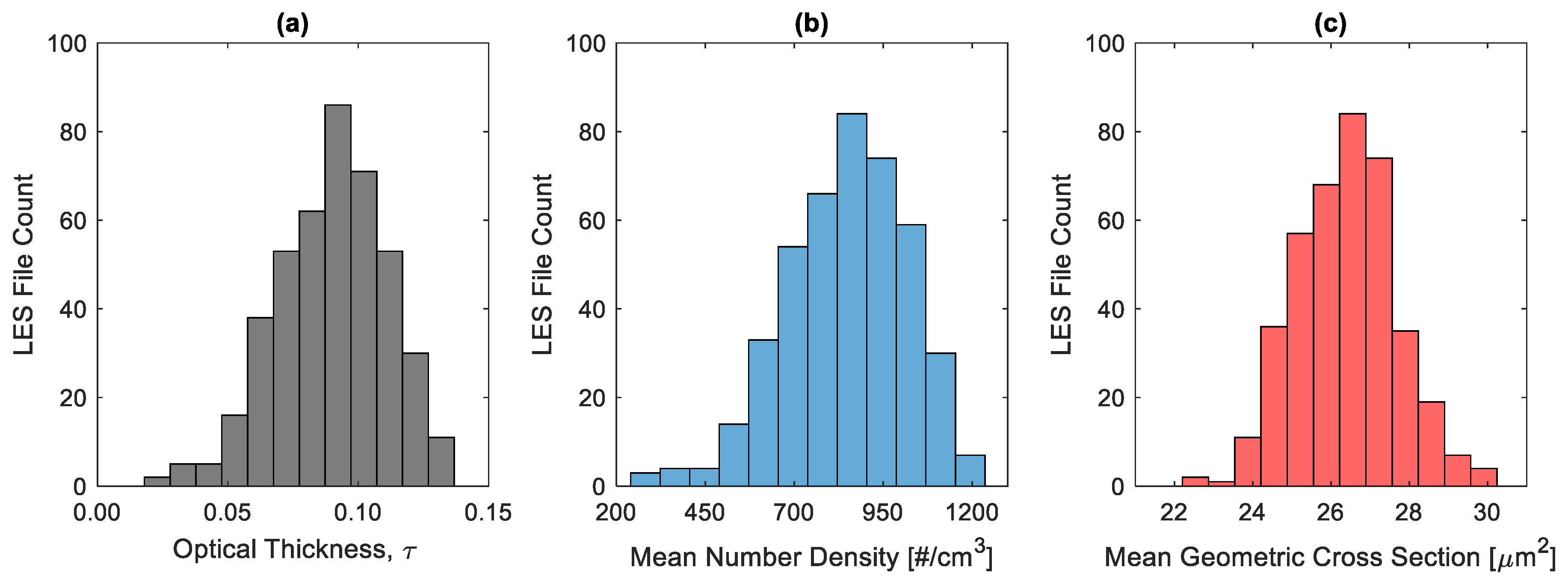
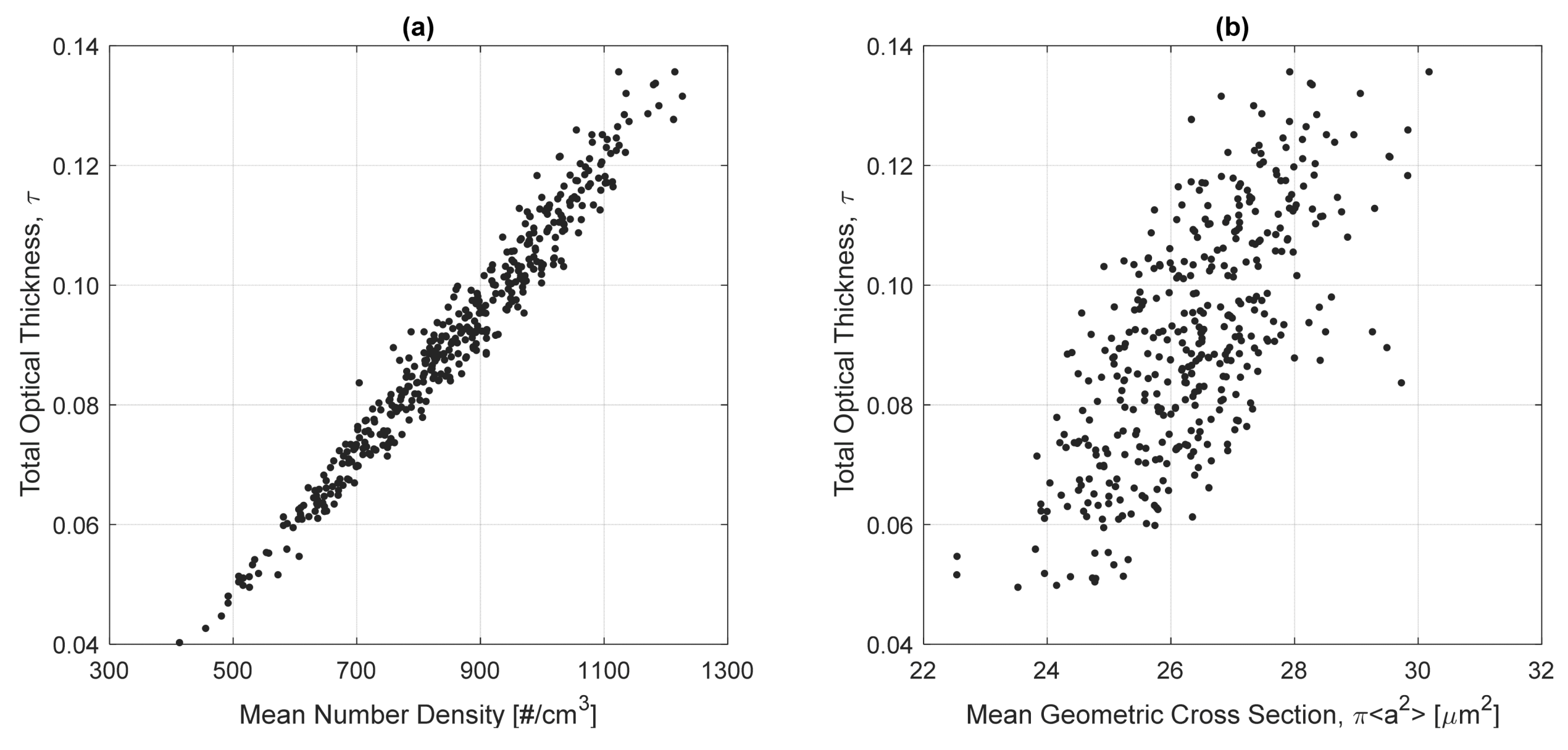

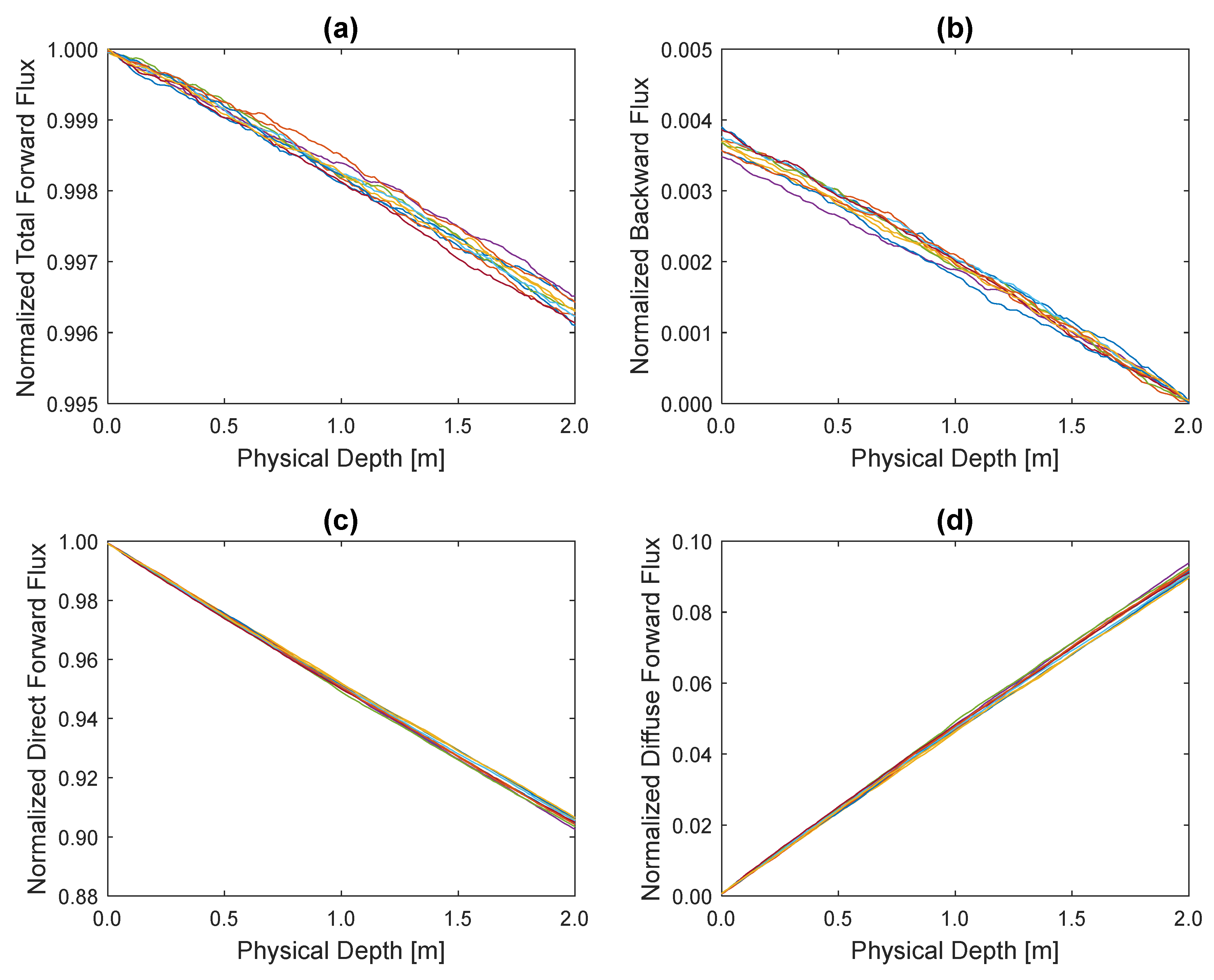

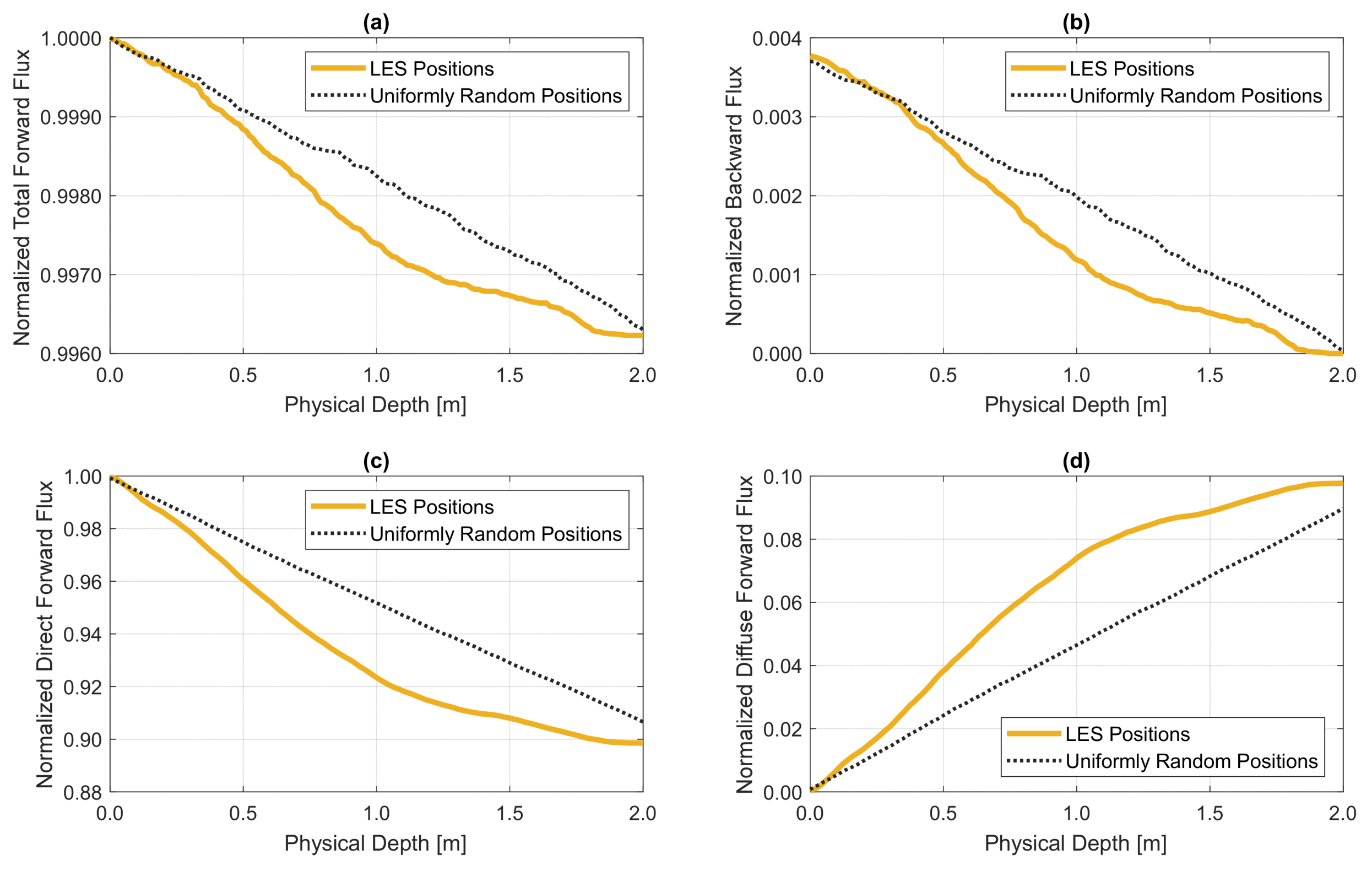
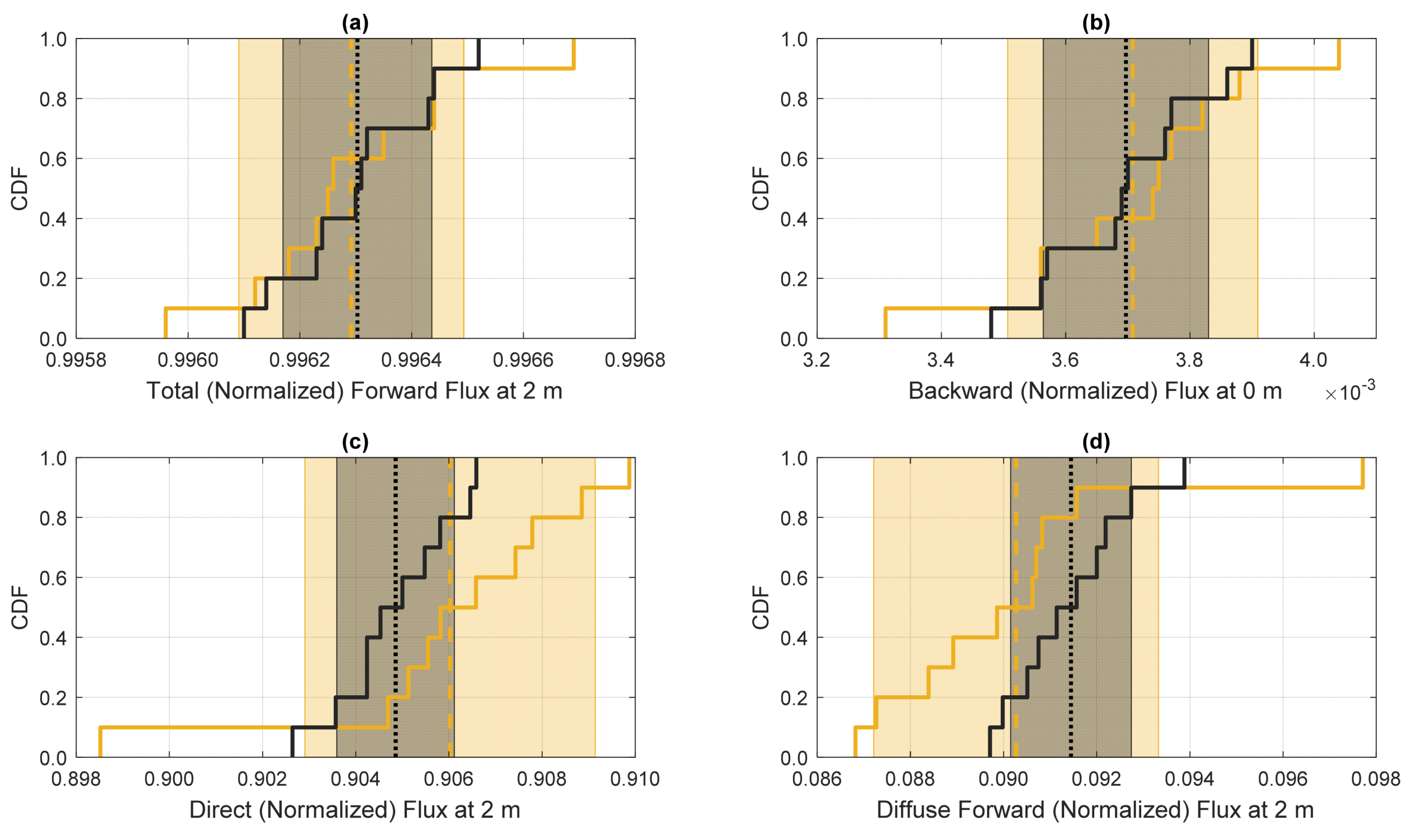
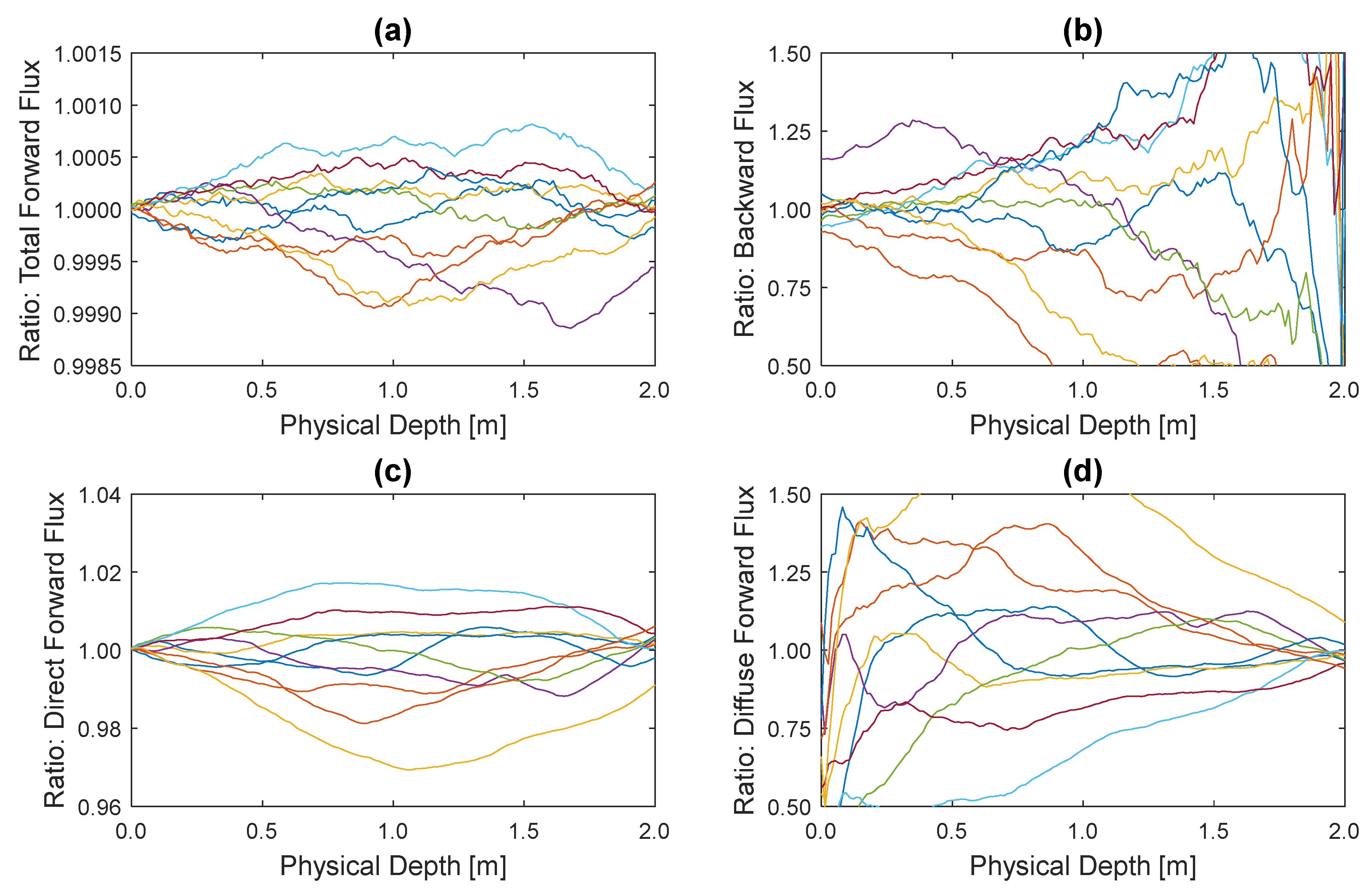
© 2020 by the authors. Licensee MDPI, Basel, Switzerland. This article is an open access article distributed under the terms and conditions of the Creative Commons Attribution (CC BY) license (http://creativecommons.org/licenses/by/4.0/).
Share and Cite
Packard, C.D.; Larsen, M.L.; Thomas, S.; Cantrell, W.H.; Shaw, R.A. Light Scattering in a Turbulent Cloud: Simulations to Explore Cloud-Chamber Experiments. Atmosphere 2020, 11, 837. https://doi.org/10.3390/atmos11080837
Packard CD, Larsen ML, Thomas S, Cantrell WH, Shaw RA. Light Scattering in a Turbulent Cloud: Simulations to Explore Cloud-Chamber Experiments. Atmosphere. 2020; 11(8):837. https://doi.org/10.3390/atmos11080837
Chicago/Turabian StylePackard, Corey D., Michael L. Larsen, Subin Thomas, Will H. Cantrell, and Raymond A. Shaw. 2020. "Light Scattering in a Turbulent Cloud: Simulations to Explore Cloud-Chamber Experiments" Atmosphere 11, no. 8: 837. https://doi.org/10.3390/atmos11080837
APA StylePackard, C. D., Larsen, M. L., Thomas, S., Cantrell, W. H., & Shaw, R. A. (2020). Light Scattering in a Turbulent Cloud: Simulations to Explore Cloud-Chamber Experiments. Atmosphere, 11(8), 837. https://doi.org/10.3390/atmos11080837




